
Miami New Times images: Photo-illustrations by Douglas Winter

Audio By Carbonatix
I have to admit I’ve entirely forgotten plenty of New Times covers – and cover stories – including a ton of the latter that I edited. So it is with the two February 1995 covers paired above. But seeing the cover on the right brought back memories.
Suffice to say I miss the days when we had time for headline-writing. The typical longform feature was written over the course of weeks, occasionally up to a month or more, and, in most instances, edited from start to finish the week prior to going to press on Monday evening.
Unearthing that February 9 cover brought back the pleasure of having days (literally, days) to let headline treatments stew in the unconscious. That one was a Steve Almond story about a remarkable spate of crimes of passion in Hialeah – timed to coincide with Valentine’s Day, no less. Out of nowhere, I suddenly remember typing: Love Hurts: Roses are red/Rubies are redder/A knife will kill your sweetheart/But a .38 works better.
Just a tinge of the ol’ epiphany.
Enough.
The tale of the tape:
February 2-8, 1995: 112 pages, 30 of which were devoted to the classified ad section
February 9-15, 1995: 128 pages, 30 of classifieds
February 16-22, 1995: 120 pages, 30 of classifieds
February 23-March 1, 1995: 120 pages, 30 of classifieds
And on to the highlights:
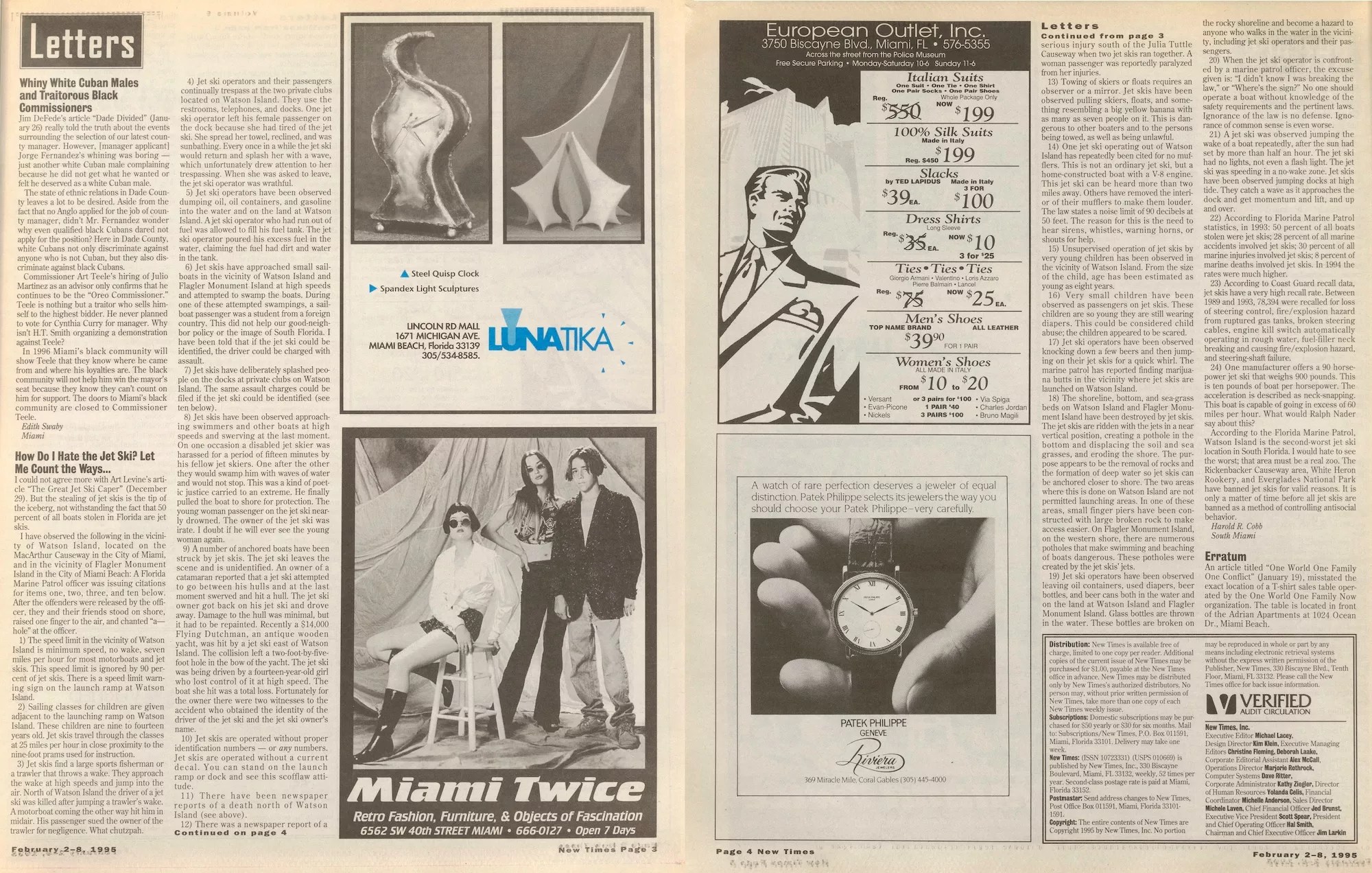
The letters section of the February 2-8, 1995, issue of Miami New Times
Miami New Times image
We used to get letters from readers, sometimes a lot of them. In the February 2-8 issue of 1995, we only had room to publish two of them – the fact that there was no room for a comics page in that paper indicates space was tight. But also, that second letter, the one from the Jet Ski hater, is – let’s just go with “a sight to behold.” So much so that it inspired a subsequent letter writer to attempt to outdo it two weeks later. But that’s a story for another time. Meanwhile, it’s impossible to properly behold it as rendered above, so here it is in all its PDF glory.

A Buddy Hickerson illlustration that accompanied Jim DeFede’s story, “Navel Maneuvers,” in the February 2-8, 1995, issue of New Times
Miami New Times image/Illustration by Buddy Hickerson
Staff writer Jim DeFede took one for the team to deliver a news story in that first issue of February.
Behold “Navel Maneuvers: A fat guy who swam in Jell-O, a Grand Canyon of female cleavage, and enough Wesson oil for a fried-chicken cookoff. We watched it all so you wouldn’t have to.” Indeed, the subject matter provided prime red meat for a New Times reporter’s keyboard cleaver, in that tickets for a Super Bowl cruise billed as “Hedonism on the High Seas” went for $350 to $2,000. Among the advertised enticements: 200 naked showgirls and dozens of pro football superstars, nude massages, hot coed bubble baths, nude limbo contests, and the opportunity to frolic with girls in a Jell-O-filled pool. Better still, the cruise was the brainchild of Michael J. Peter, the proprietor of a “network of nudie bars strung like prurient pearls around the world” who was also under federal indictment for threatening competitors he believed were trying to recruit his dancers, skimming profits, and withholding taxes from one of his clubs to pay off members of the Mafia.
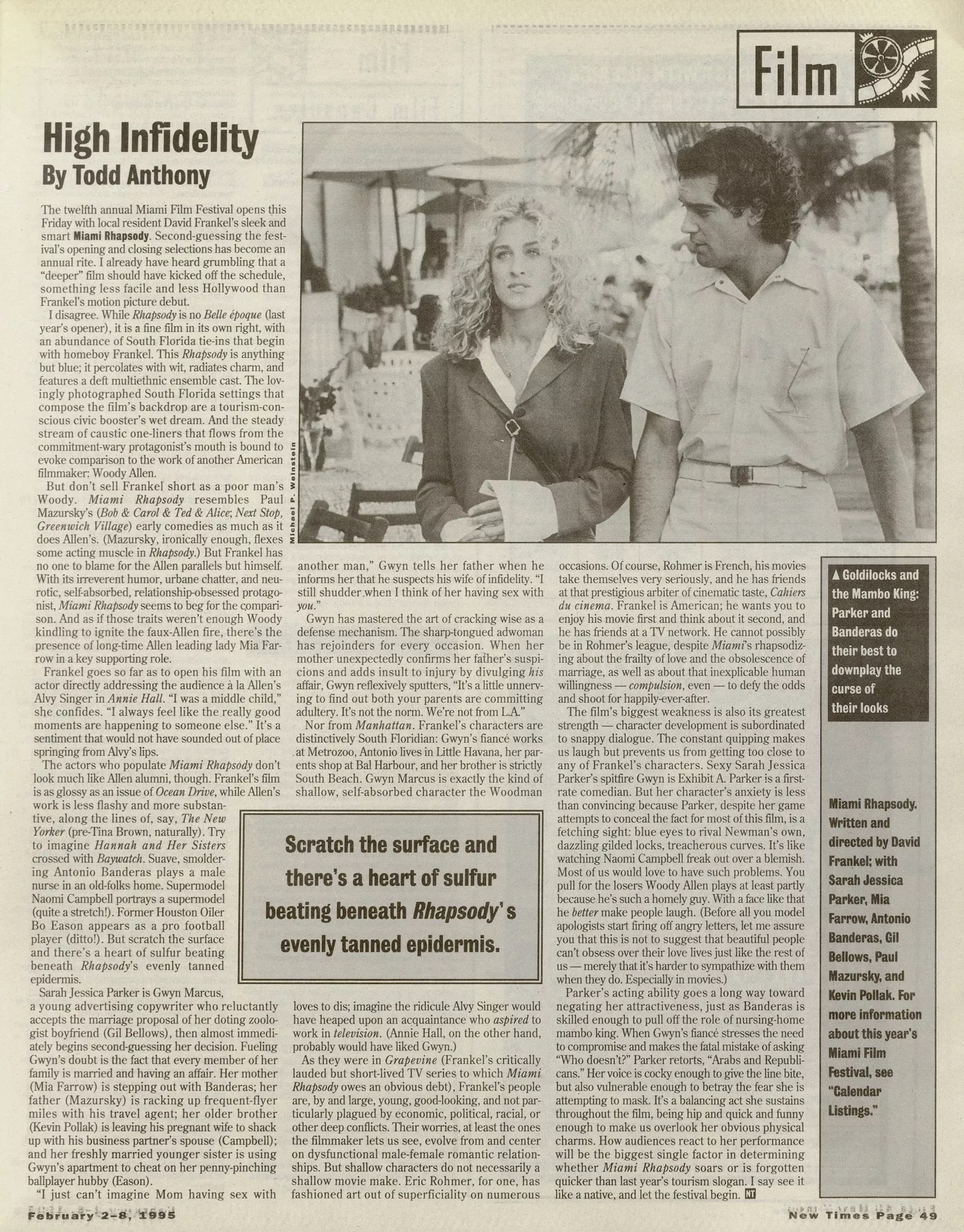
Staff writer Todd Anthony’s review of Miami Rhapsody as it appeared in the February 2-8, 1995, issue of New Times
Miami New Times image
Todd Anthony, meanwhile, was on the Miami Film Festival beat, reviewing the fest’s opening-night feature, Miami Rhapsody, writtten and directed by Miamian David Frankel, starring Sarah Jessica Parker, Mia Farrow, Antonio Banderas, and Paul Mazursky, and chock-full of familiar settings.
“This Rhapsody is anything but blue; it percolates with wit, radiates charm, and features a deft multiethnic ensemble cast,” Anthony wrote. “The lovingly photographed South Florida settings that compose the film’s backdrop are a tourism-conscious civic booster’s wet dream.”
Frankel went on to direct stuff like The Devil Wears Prada (2006) and Marley & Me (2008) – the latter of which is also set in Miami, so there’s that. The review appears not to have made it into our online archive (ghosts in the machine!), but if squinting at a jpeg doesn’t do it for you, click to read “High Infidelity” in PDF form. Oh, and here’s an ad touting the Miami Film Festival lineup (sponsored by the Miami Herald LOL).
Speaking of ads:
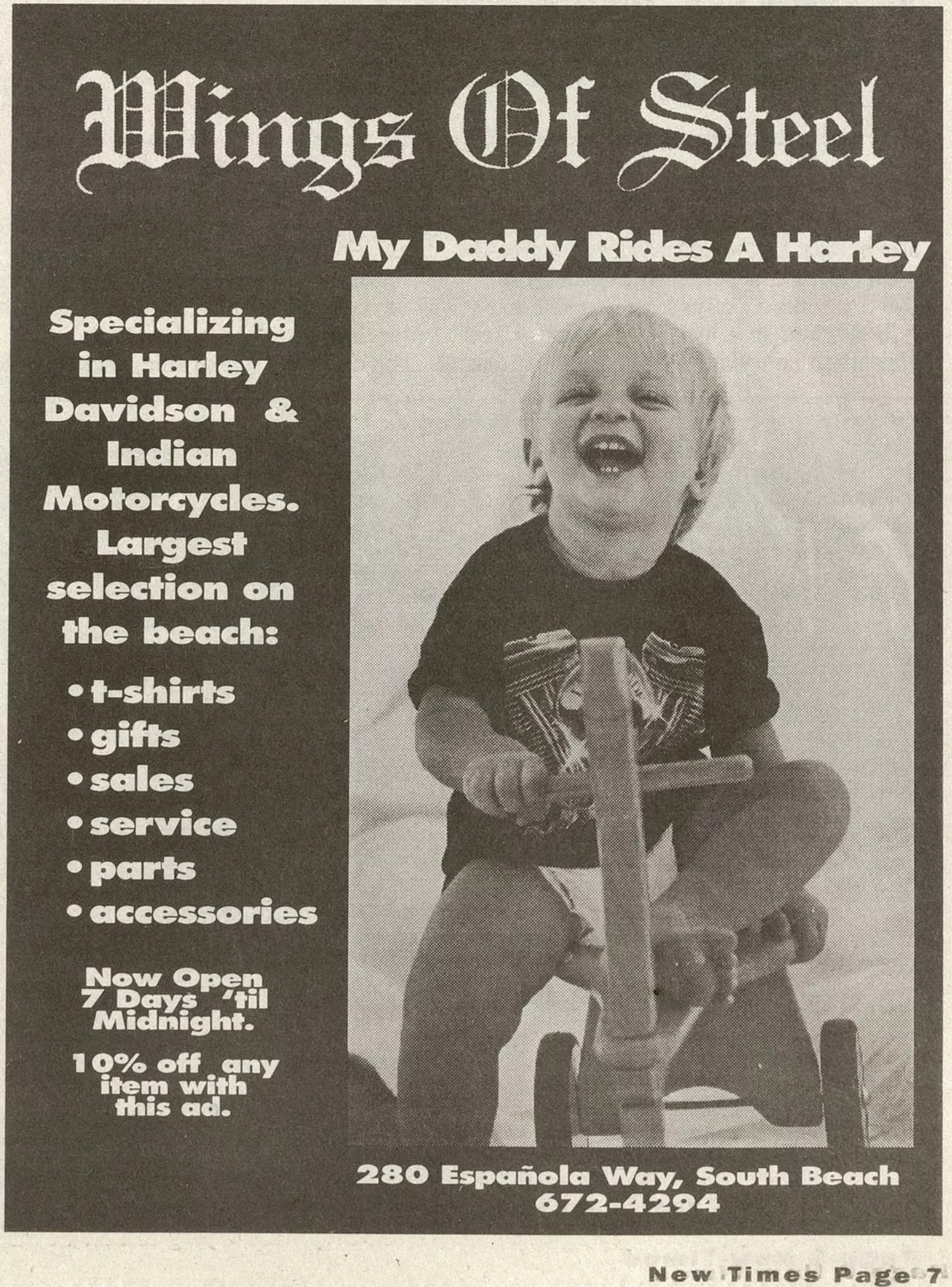
A quarter-page ad from the February 2-8, 1995, issue of Miami New Times
Miami New Times image
This showroom at 280 Española Way would have been located just off Washington Avenue a half-block north of the Cameo Theatre, where Branford Marsalis’ Buckshot LeFonque was set to perform later in the month.
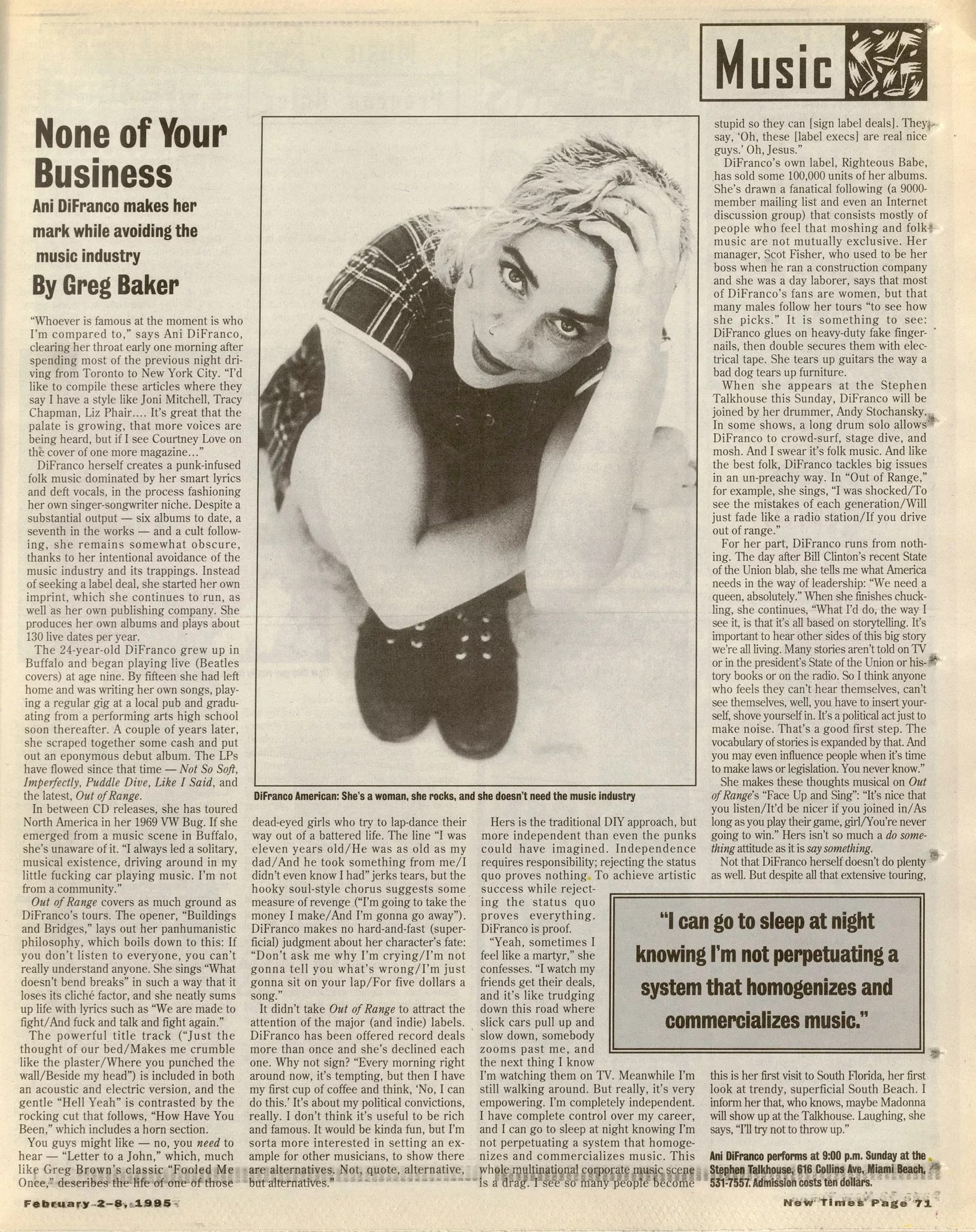
Music editor Greg Baker’s interview with Ani DeFranco as it appeared in the February 2-8, 1995, issue of New Times
Miami New Times image
“Whoever is famous at the moment is who I’m compared to,” Ani DiFranco told music editor Greg Baker. “I’d like to compile these articles where they say I have a style like Joni Mitchell, Tracy Chapman, Liz Phair…. [I]f I see Courtney Love on the cover of one more magazine….”
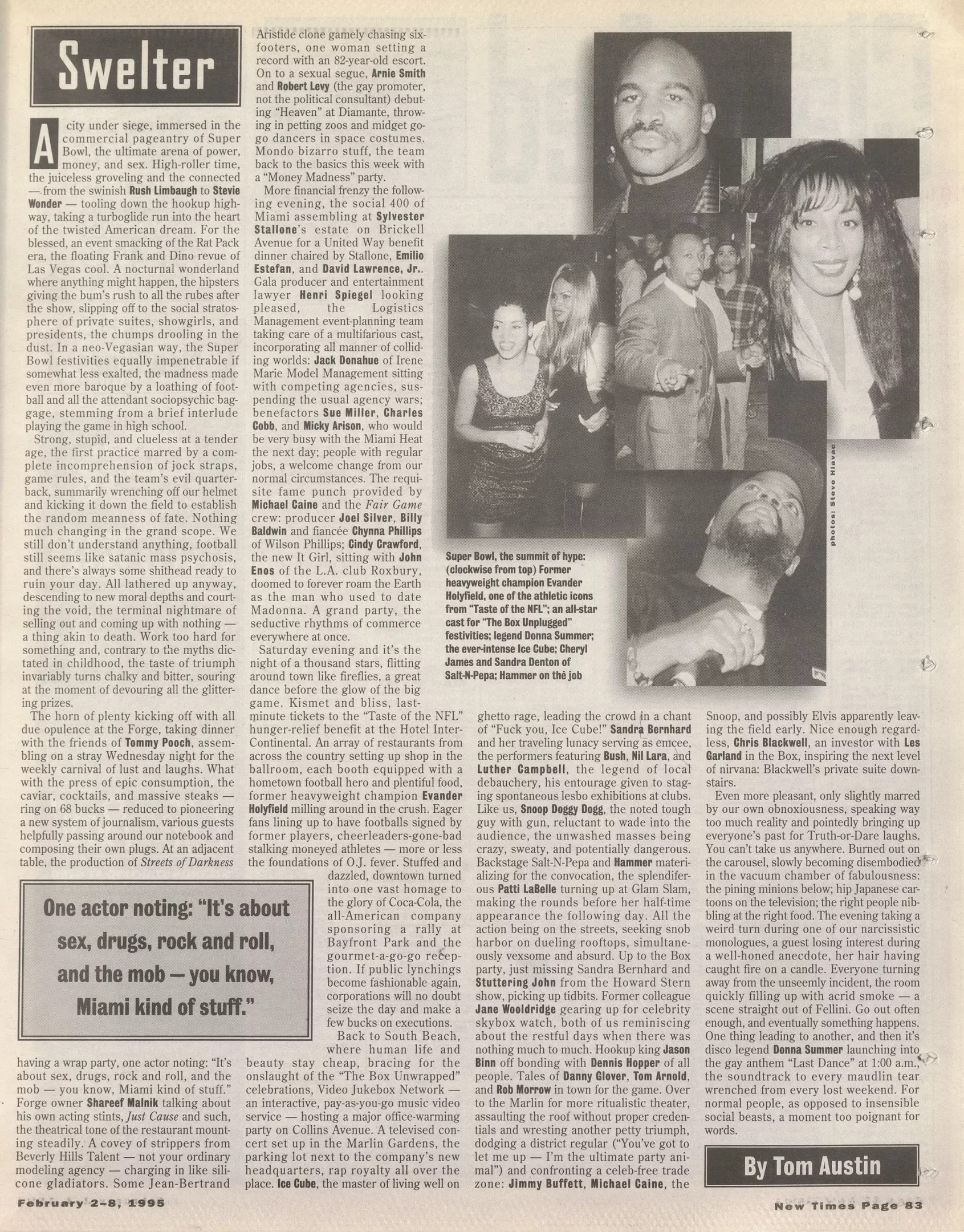
Tom Austin’s weekly “Swelter” column as it appeared in the February 2-8, 1995, issue of New Times
Miami New Times image
And amid it all, “Swelter” columnist Tom Austin took in Super Bowl Week and played it back:
“You can’t take us anywhere. Burned out on the carousel, slowly becoming disembodied in the vacuum chamber of fabulousness: the pining minions below; hip Japanese cartoons on the television; the right people nibbling at the right food. The evening taking a weird turn during one of our narcissistic monologues, a guest losing interest during a well-honed anecdote, her hair having caught fire on a candle. Everyone turning away from the unseemly incident, the room quickly filling up with acrid smoke – a scene straight out of Fellini. Go out often enough, and eventually something happens.”
Austin died from cancer at 66 in 2022. Longtime New Times editor Jim Mullin had hired him to write “Swelter” (and hired me too, but that’s another story), paying him $200 per column when he started in 1991. It was an extraordinary moment in the evolution (if that’s the right word) of South Beach. Mullin and Austin sensed it then; to say they “knew” it would be to fail to appreciate the fact that no one possibly could have – and besides, most people didn’t give it any thought.
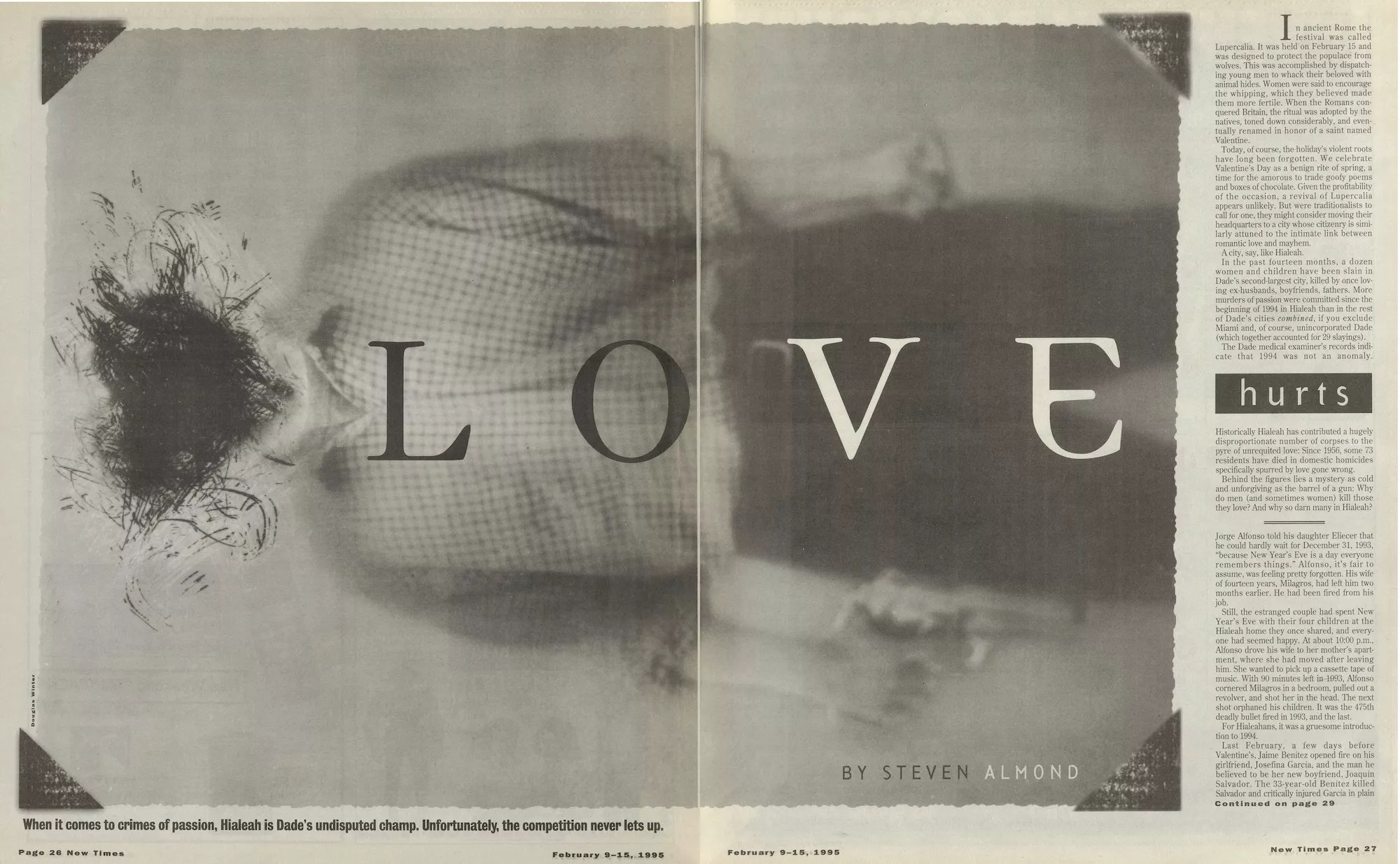
The opening spread for Steven Almond’s longform story, “Love Hurts,” in the February 9-15, 1995, issue of New Times
Miami New Times image/photo-illustration by Douglas Winter
“The Dade medical examiner’s records indicate that 1994 was not an anomaly. Historically Hialeah has contributed a hugely disproportionate number of corpses to the pyre of unrequited love: Since 1956, some 73 residents have died in domestic homicides specifically spurred by love gone wrong,” Steve Almond wrote in “Love Hurts” as Valentine’s Day approached in 1995.
And: “Staffers at Dade’s Domestic Violence Court have not compiled any official demographic figures, but Ivon Mesa, the court’s acting intake director for those who seek injunctions, did begin her own unofficial tally last year. The reason? ‘When I would speak to victims, I found that a lot of them were Cubans, and I wanted to know, for instance, what sort of cultural factors might contribute to the violence, not just for Cubans, but all the groups here.’…
“Mesa, who lived in Cuba for nearly half of her 25 years, says the numbers are partly a byproduct of culture shock. ‘Domestic violence is still a taboo subject in Cuba. You just don’t hear anyone talking about it. Not in the media or on the street. They don’t even know that it’s a crime. So you have people coming here with this mentality, applying the same rules as in Cuba, and all of a sudden what they’ve been doing for the past 30 years is a crime.'”
(Footnote: Steve’s story included a sidebar – unarchived, sad to say – in which he noted, “This county routinely tops Florida in domestic homicide stats, and, as might be expected, the emphasis is on the bizarre,” then proceeded to describe some choice examples. The headline: “50 Ways to Cleave Your Lover.”)

A 1995 photo of Greg “Bald Eagle” Jackson, posing in front of the Miami Heat billboard he modeled for
Miami New Times image/Photo by J.K. Yearick
Which brings us to the issue of February 16, and “In the Paint,” a short piece Almond wrote about a billboard campaign featuring Greg “Bald Eagle” Jackson sssmoookin’ through the air. As Almond shared, the Bald Eagle didn’t play for the Heat – or any pro hoops team for that matter. He worked for Motorola, in the pager department.
Almond called the TV station that cosponsored the billboards. “‘With all the trades they’ve made, our management and the Heat were worried about putting a specific player on the billboard,'” Channel 33 art director told Almond. “‘So we decided to go with a generic-type player.'”
“He’s a very nice guy,” Panson added. “He just doesn’t happen to be a Heat player.”
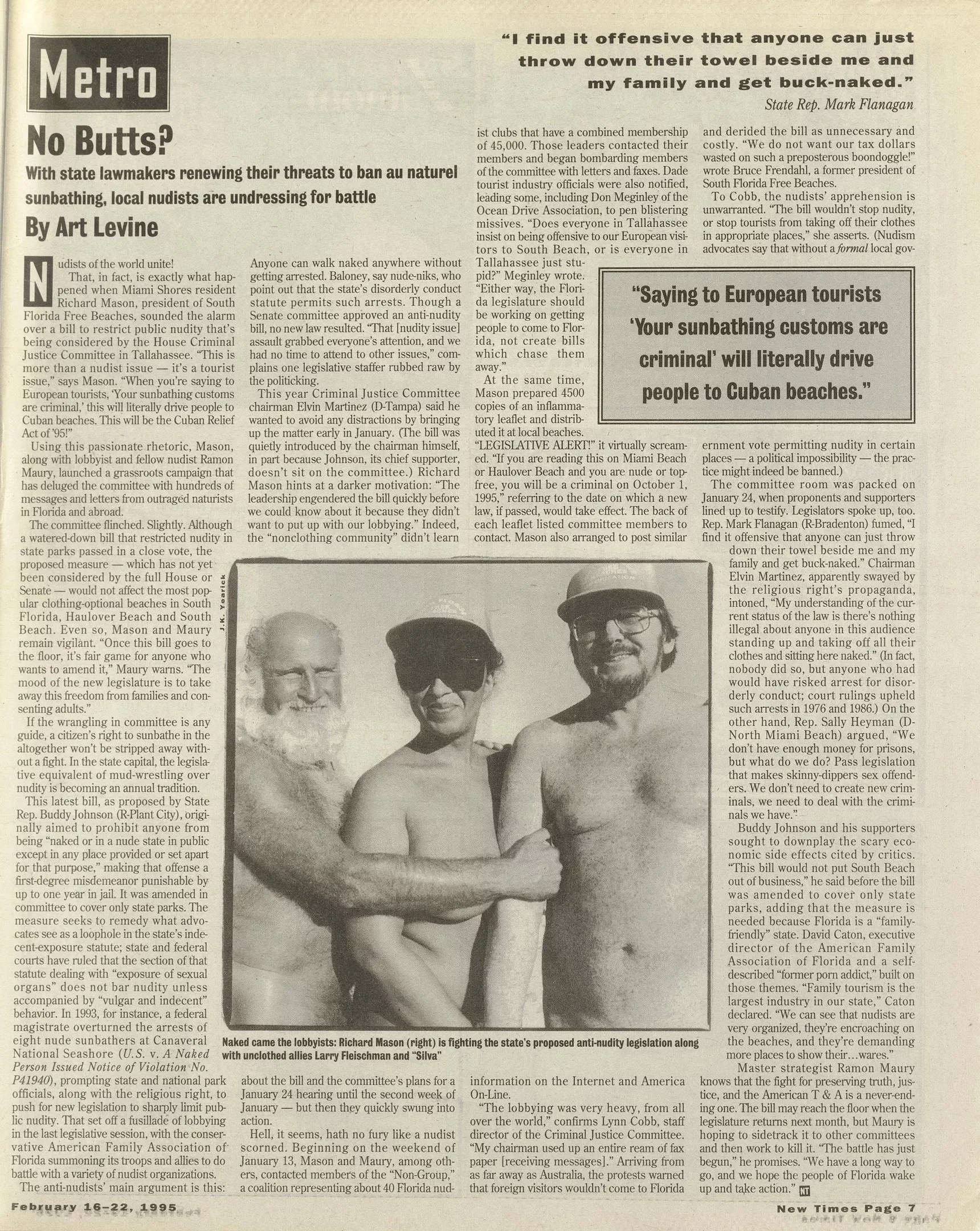
A page from the Metro section as it appeared in the February 16-22, 1995, issue of New Times
Miami New Times image/Photo by J.K. Yearick
Also from the Metro section, “No Butts” was an…exposé by Art Levine, the paper’s associate editor at the time. Most locals were (and still are) familiar with the European etiquette observed on South Beach and the famed clothing-optional stretch of Haulover Beach. But the 1980s and ’90s saw periodic challenges to the naturist lifestyle, and the naturists weren’t having it.
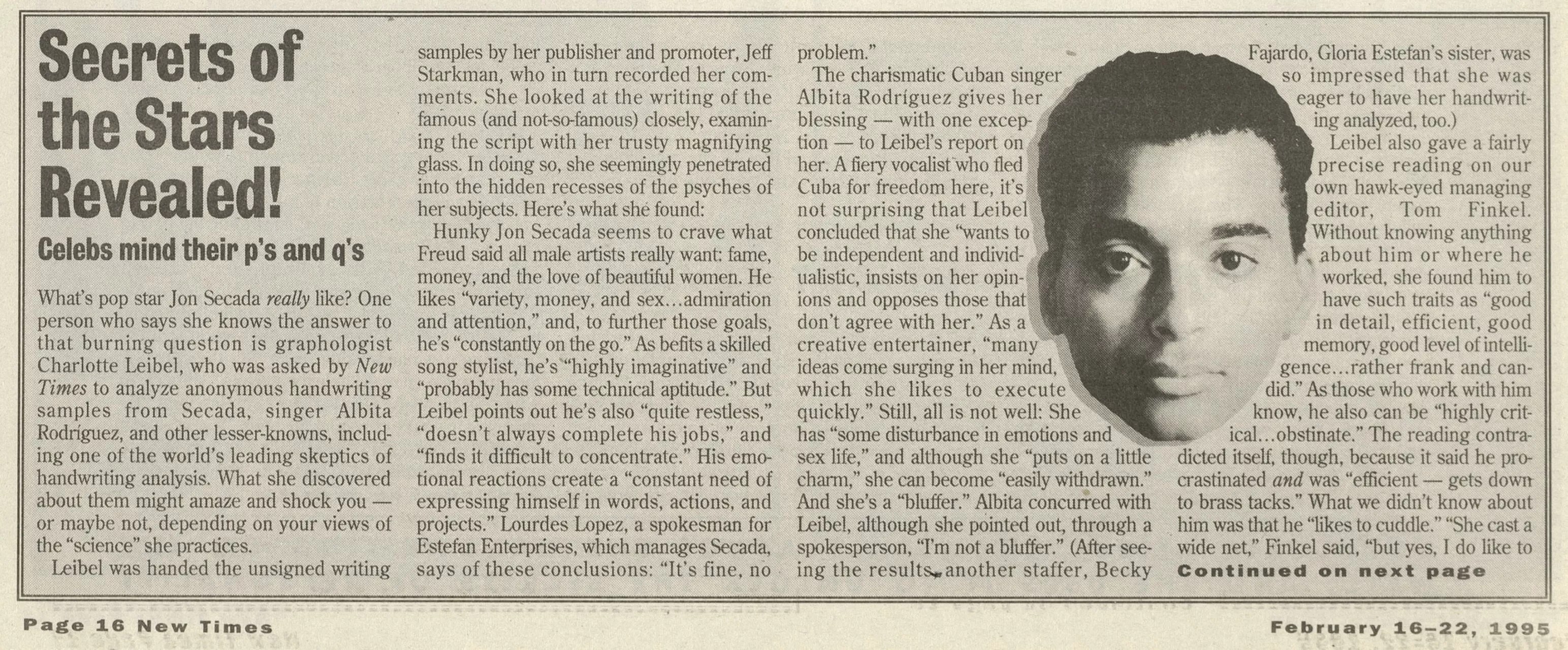
Detail of a page from the February 16-22, 1995, issue of New Times
Miami New Times image
The same issue included “Writes of Passage,” a profile by Levine about 95-year-old Charlotte Leibel, a Miami Beach resident and longtime handwriting analyst. Leibel, who’d authored a book two decades earlier called Change Your Handwriting…Change Your Life, had recently been featured on network TV shows, where she parsed the handwriting in O.J. Simpson’s infamous “suicide note.”
“During Leibel’s segment on Hard Copy, the TV announcer breathlessly intoned, ‘Now one of America’s leading handwriting experts has just finished examining the note, and what she has to say may shock some of O.J. Simpson’s supporters,'” Levine imparts. “From her couch in her apartment in a public housing project on Alton Road, Leibel told the TV interviewer, ‘When I saw his writing, I was pretty well convinced that he was capable of violence.'”
I’d be remiss if I didn’t note Levine’s sidebar, “Secrets of the Stars Revealed!” because – well, because in excavating the story I saw that I’m in it: Art inveigled me to supply a handwriting sample for Charlotte to analyze.
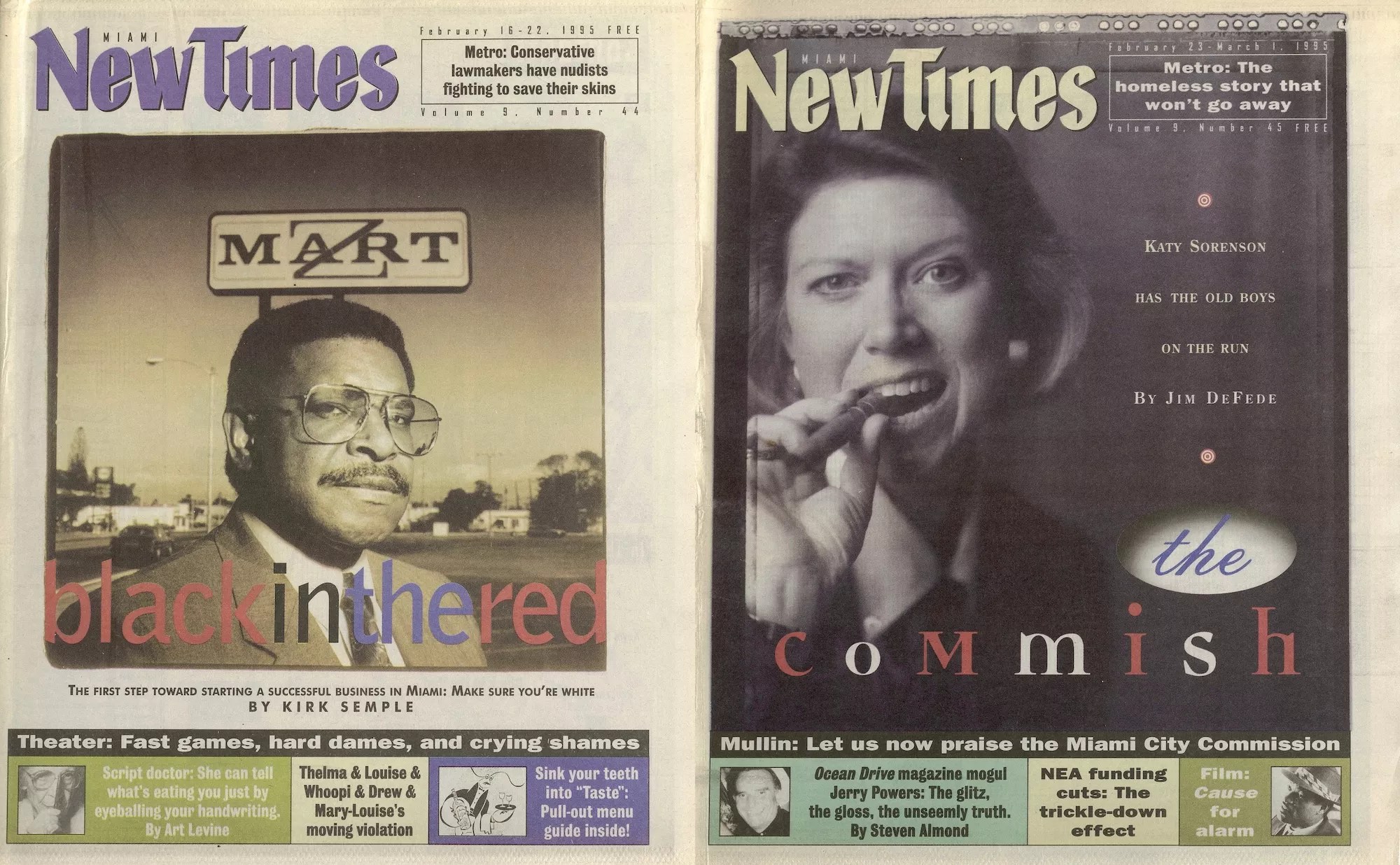
The covers of the February 16-22 and February 23-March 1, 1995, issues of New Times
Miami New Times cover images/Photos by J.K. Yearick
If it’s hard news you were after, the issues of February 16 and February 23, 1995, did not disappoint. Staff writer Kirk Semple’s “Black in the Red,” featured on the cover of the February16-22 edition, examined the promise and failure of Z Mart, a Black-owned department store in Liberty City that had filed for bankruptcy the previous fall, having been open for a scant three years.
Charles Howze, the only cofounder still involved with the business till the end, didn’t blame the neighborhood for not supporting the effort. “Everybody wants to blame the consumers,” he told Semple. “If you can convince the world that the community won’t support its own organization, what better excuse is there for banks and other investors not to invest in the community? The reason black businesses don’t survive in Liberty City is that we don’t have enough resources to compete.”
Also in that issue, Jim Mullin wrote a scathing column about the City of Miami’s plans to “Build a Park, Turn a Profit” on three neglected, publicly owned tracts.
“Thanks to the wise men at Miami City Hall, Virginia Key, Bicentennial Park, and Watson Island are in the process of shedding their tarnished reputations as haggard old bats – repositories for bums, trash, and sewage – and, barring unforeseen obstacles, will emerge as the most beguiling public spaces in all of South Florida,” Mullin gushed in the “portray idiots as geniuses” tone he frequently deployed, aways to eviscerating effect.
“Build a Park, Turn a Profit” didn’t make it into the online archive, but click that there title and you can read a PDF.

The opening of a New Times feature story profiling Ocean Drive founder Jerry Powers, published in the February 23-March 1, 1995, issue of the weekly paper
Miami New Times image
Also in that issue, a profile of Ocean Drive magazine founder Jerry Powers by Steve Almond that was a hell of a lot less flattering than any story that had run in then-two-year-old Ocean Drive. Almond dug into Powers’ legal problems past and present and revealed that one of the investors who bankrolled Ocean Drive was none other than South Beach interloper Thomas Kramer – who had himself been the subject of a New Times exposé cowritten by Almond and Jim DeFede, one that, sadly, seems to have fallen through the internet cracks (at least for now).
“I can’t help but feel that part of the reason this story is being written is due to disgruntled employees,” Powers told Almond, “and the fact that Ocean Drive has taken a huge chunk of advertising revenue from New Times.”
Read “The Powers Behind Ocean Drive” and judge for yourself.
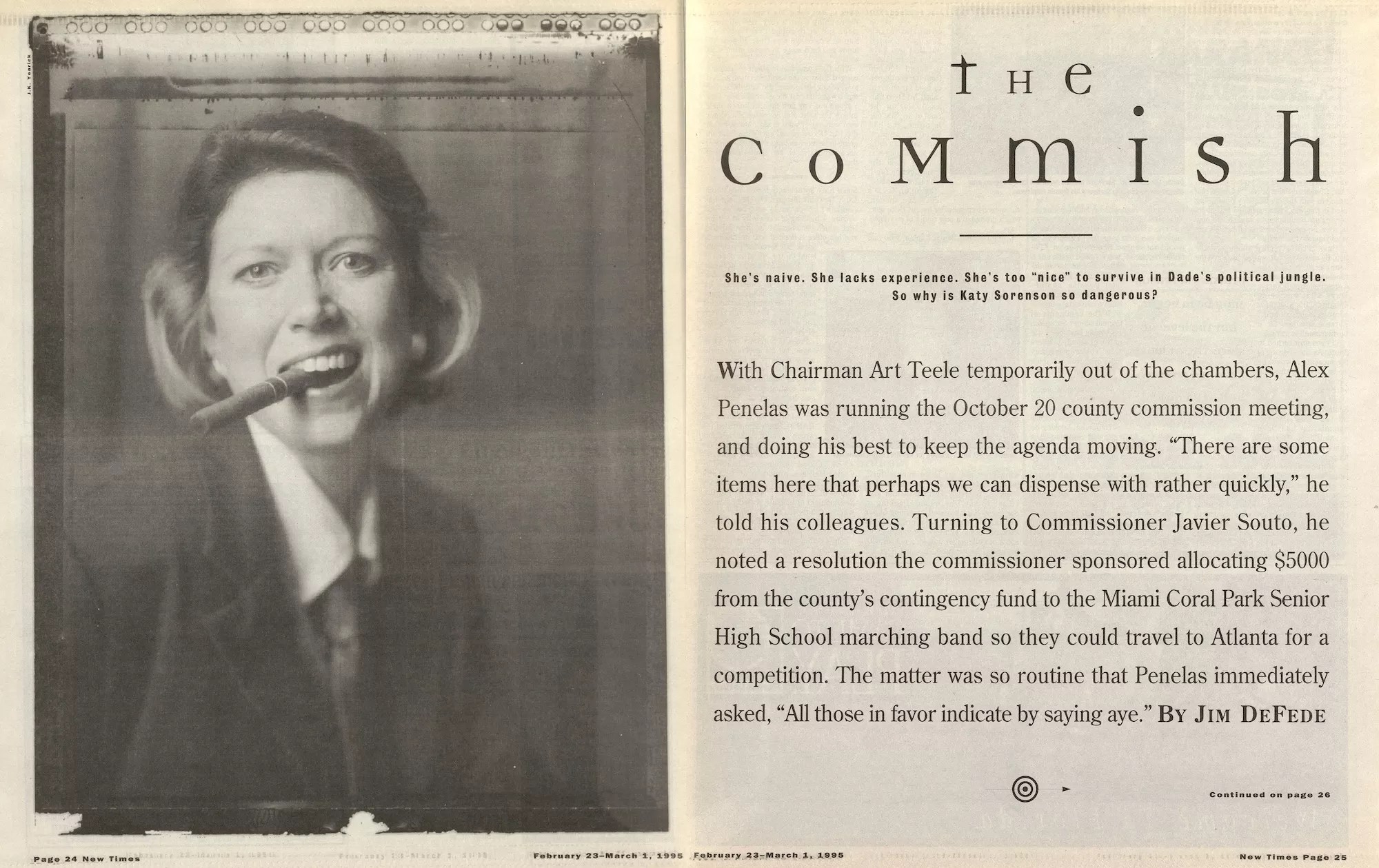
The opening spread of “The Commish,” a feature profile of Dade County Commissioner Katy Sorenson that appeared in the February 23-March 1, 1995, issue of New Times
Miami New Times image/Photo by J.K. Yearick
And then there was Jim DeFede’s profile of newly elected Dade County Commissioner Katy Sorenson, who was making waves in county government like no one in recent history.
“Today commission Chairman [Art] Teele describes Sorenson as ‘deceptively brilliant,’ adding that because of her normally nonconfrontational style, she continues to be underestimated,” DeFede wrote in “The Commish.” “‘On the dais, what Katy does is ask questions,’ Teele observes, ‘and it appears she is trying to find her way, when in reality she is already far down the path and she’s just trying to bring the rest of us along. People totally underestimated her. In retrospect it was probably the best thing that could have happened to her, because in politics if you beat the expectations, you are seen as rising. Katy is beating all the expectations, and that is a brilliant position to be in.'”
DeFede’s profile aged well. In 2010, when Sorenson stepped down from county politics, then-New Times staff writer Francisco Alvarado wrote, “Can’t blame Commissioner Katy Sorenson for calling it a day. Sixteen years is a long time to spend battling the unreformable majority on the county commission. For a decade and a half, Sorenson has consistently been the voice of ethical reason on an elected body that has often voted in favor of controversial legislation, to the detriment of residents…. With her departure, it will be difficult to find someone to step up and fight for Miami-Dade citizens the way she has. I’m hoping I’m wrong.”
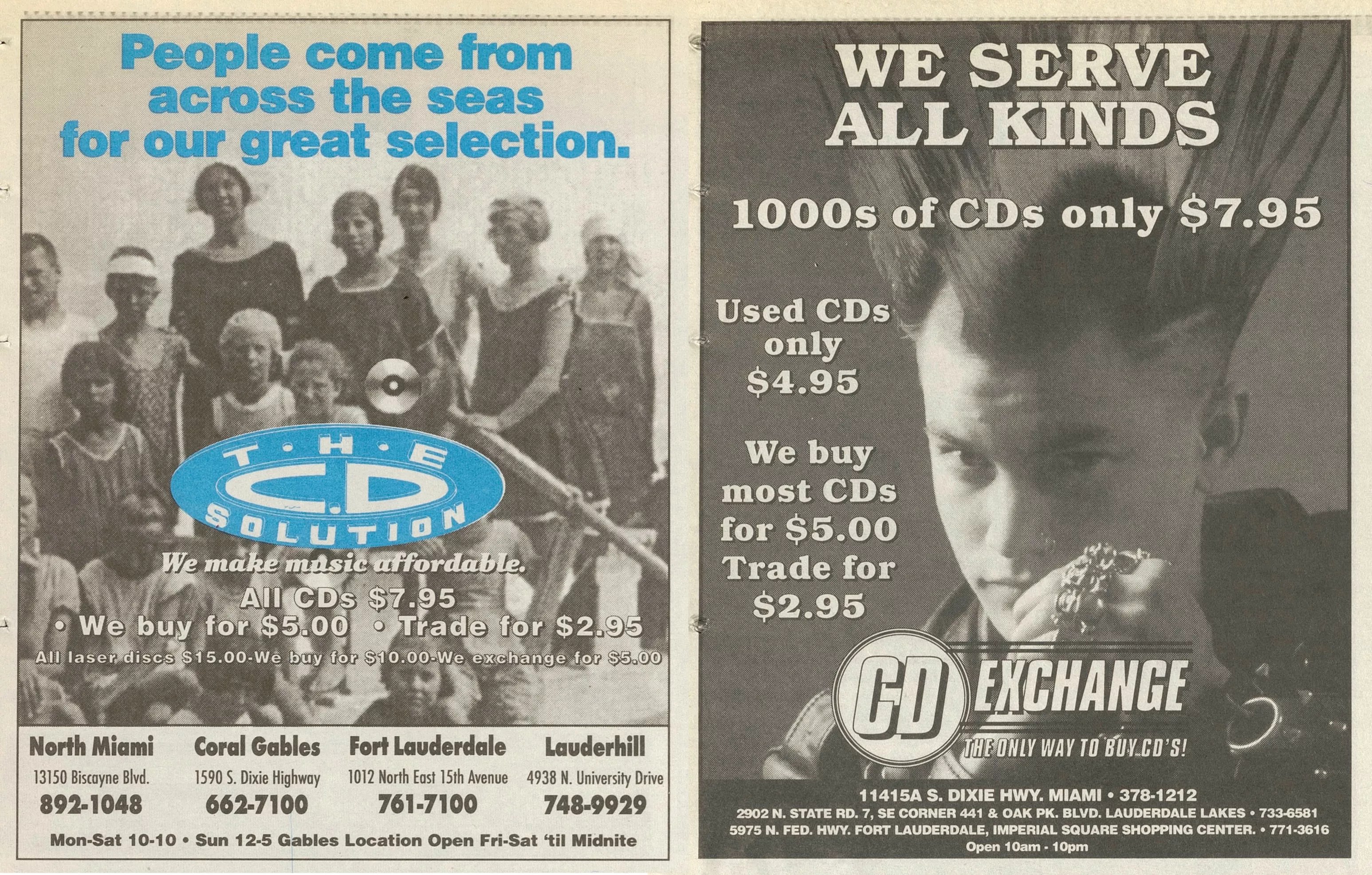
Two quarter-page ads from two different February 1995 issues of New Times
Miami New Times image
Oh, and: Anyone remember when CDs were a thing?
See you in March!
Editor’s note: This is part of a series that will endure for as long as we and our readers can stomach it. Click the link to read previous installment(s) of “30 Years Ago This Month.”